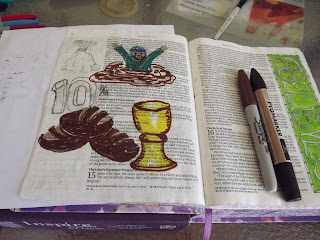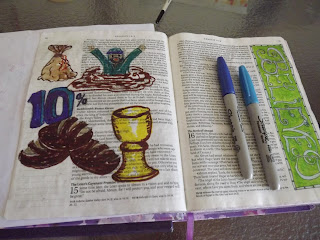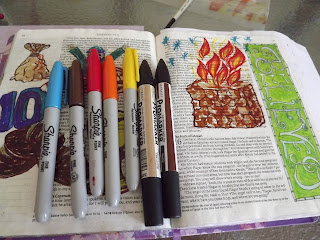Our story continues on the next page with the establishment of Ismael's descendants and we will explore this as well.
Genesis 14, 15 and 16 look like this in the Inspire Praise Bible.
I prepare the pages with Zellen Clear Gesso.
The pages look like this when the gesso is dry.
I use Mont Marte Adult Colouring Markers to colour the illustratin in the left margin.
I use a Derwent Inktense pencil to colour the background of the illustration.
I then paint the Inktense penciling with water to dissolve it.
When I am done, my pages look like this.
Chapter 14 starts at the bottom of the previous page and I therefore need to page back first. In these lines we learn about a revolution that broke out among the rulers of the area where Lot had settled. As the page is already very busy, I do not want to add anything that will add too much.
I remember that I have a stencil that resembles an old-fashioned shield in one of my stencil books.
I use a Faber-Castell Artist's Pitt pen to stencil the shield over the text telling us of the political upheavals.
I will not add anything to the centre of the shield, because of the busy-ness of the rest of the page.
These particular pages now look like this.
Full scale war broke out in the area of the unrest, with two alliances drawing up ranks against each other. When one of these alliances gain the upper hand, the other has to flee before them. In their haste to flee before the enemy, some of the retreating soldiers fall into tar pits that litter the area, which causes the demise of many. For some reason this image, which is largely inconsequential to the larger unfolding story of the Bible, stuck in my mind and I decided to illustrate it in pencil.
I used Sharpie markers and a ProMarker to colour the illustration. As I am doing this, my mind remains busy with the dire plight that these people suffered. I had brushed over the names of the warring parties, as these held little meaning to me. I now paid closer attention to these. I am surprised to discover that the people who fell into the tar pits, are the ones who came from Sodom and Gomorrah. We will soon read more about these people, in the upcoming chapters, but I think most of us are familiar with the story of the destruction of these cities as a result of their godless behaviour. Too often I have heard people complain about the raw deal that life had given them, blaming God for allowing this to happen to them. I do not wish to establish some general rule here, as I know that there are lots of believers who suffer, as well as unbelievers who prosper, but a thought did come to mind that I would like to share. Still, I have to wonder if these people would even bother with mentioning God's name, except in blasphemy, if they had prospered. Would they not then have taken all credit for their prosperity upon themselves? There is a general rule in this, I think: If you can not mention God's name in submissive prayer before the trouble starts, don't mention His name in blame when you find yourself in a pit of tar.
When the invading armies raided the cities of the fleeing godless, they captured and carried off property, people and animals with them. Among these, were Lot, his family and possessions. One of his slaves managed to escape to alert Abram as to what was happening. Abram then mobilized his allies and men and set off in hot pursuit, managing to free Lot and recover his possessions. In the end, him and his allies walked away with the spoils of war. Abram is then met by one of the most mysterious characters in the Bible, namely Melchizedek of Salem. This may simply have been a normal person of exceptional rank, or it may have been an angel, or even Jesus Himself. In Psalm 110 and Hebrews 7, he is made to be a sort of prototype of Christ. In Psalm 76 it is implied that Salem is synonymous for Jerusalem. Certainly his significance would be overlooked had it not been for these later references to the character. A couple of significant things happen here. Abram pays a tithe to this man, without seeming to have any reason to do so, except that Melchizedek was a priest of the Most High God. Melchizedek served Abram bread and wine when he blessed Abram, which reminds us of the Holy Communion which would be instituted by Jesus a couple of millennia later. I do a couple of quick pencil sketches to illustrate these aspects of the meeting.
As Abram is giving away 10% of what he had, the king of Sodom came to him, asking him to simply let the people go, but to keep the property that had been raided for himself. This must have constituted a huge capital gain. It is basically the property from the people of a whole city that Abram would have gained. But Abram declines. Abram lived from the blessings received by God. He lived on God's promises. If financial gain or wealth had been his aim in life, he would never have left his prosperous life in Haran. This is one of the many reasons why Abram is called the Father of the believers. I use Sharpie markers to colour the wine glass.
I use a Sharpie and a ProMarker to colour the bread in shades of brown. How often has temptation presented itself to us in the shape of wealth and prosperity when we had blindly grabbed at it, thanking God for His provision, without even stopping to ask if this had really been provided by Him. It is all about relationship. Do not simply blindly think that you have received a 'sign' when something good comes your way. It is not necessarily a 'sign' of God's blessing. Sometimes it is simply temptation, especially when it comes from those who do not trust God or believe in Him. Don't imagine that you know God's will, ask Him for His will. He is as alive and active in people's lives today, as in the days of Abraham. More so, for He is living inside of us in the shape of His Holy Spirit who guides us and reveals His will to us. Never forget the key word 'relationship.' This is also the word I have stenciled on the outside of my Bible at the beginning of this journey. Do not loose sight of that.
I use Sharpies and a ProMarker to colour the bag with the tithe.
Then I use Sharpies to colour the 10% journaled in the margin.
In chapter 15 we gain insight into a vision that Abram had. In this vision God came to talk to him to reaffirm His blessings and promises from before. Abram mentions to God that these promises would have to be fulfilled in his servant, as he had no heir of his own. God assures him that an heir from his own loins would be the carrier of these promises and says that Abram's descendants would be as numerous as the stars in the sky. I include this promise in my illustration by drawing a couple of very simple stars on my page with a Sharpie. As this vision unfolds, Abram prepares a sacrifice of a number of animals which are cut in half, as well as a few birds. Th day drags on as Abram keeps guard over the sacrifice. He fell into a sleep and experienced a disturbance in his spirit/emotions. God then reveals to Abram that all will not always be well for his descendants. At some stage in their history they will experience a 400 year long period of slavery. However, God also foretells the rescue plan He had in store for them. They will be returned to the land promised to Abram's descendants. Abram would die in peace, though. As night fell, a miraculous fire was lit on the alter that moved between the sacrificial offerings. Then God reaffirms His promises of the specific land given to Abram's descendants. Not fully comprehending the miraculous aspect of the fire, I simply drew a stone altar with a fire burning on it.
In chapter 16 we encounter a very selfless act from Sarai, although it was completely unnecessary. Fully believing God's promises to Abram, but believing herself inadequate for the task, she proposes Abram conceive an heir with her maid. Abram also could not fathom that Sarai would be up to the task God had in mind, and he agreed. Hagar became pregnant with Abram's son. I had to stop reading here to contemplate how often I have tried to help God's plans ahead in my own life. We have even come up with a saying in this day and age to capture the essence of this. You will have heard this before: 'God only helps those who help themselves.' This is wholly and completely against Biblical principles. On occasions where God wish for humans to do something to bring about His will, He is very specific about who should do what, when, and where. On more occasions, He requires no human intervention whatsoever. Refrain from doing on God's behalf because you feel yourself inadequate, inapt, unable, unequipped, or lacking. God will do as He said He will do and He will provide where all hope seems lost. Relax and trust God to do as He knows best. I make a very simple drawing of a pregnant woman to indicate the pregnant Hagar.
This page is now complete, but the chapter continues on the next page.
The pregnant Hagar was a very silly young woman who scorned her mistress because of her barrenness. She must have thought herself the preferred woman in the house now. She was young, pretty, and pregnant with a much longed-for heir. When her belligerence became too much to bear, Sarai sent Hagar away, with Abram's permission. Just as Sarai's selfless act hinted at a strong bond between herself and Abram, so his actions seem to infer this. Please take note though, not all selfless acts that are born from a place of love, are necessarily good for the individual role players. Again I want to urge you to not assume to know God's will, but to rather ask Him for it. When Hagar is in the desert, she is found by an angel of God's. He instructs her to return to her mistress. He also tells her that she will give birth to Ishmael, and that his descendants will always be in conflict with their relatives. Ishmael later becomes the ancestor of the modern Arab nations, whereas Isaac through Jacob, becomes the forefather of Israel. This is thus the birthplace and origin of the modern and ancien middle eastern conflict, along with everything that the ensuing years had added to the cesspool of conflict. I illustrate the prophesied conflict and contention with a raised fist which I colour with ProMarkers.
This page looks like this when I am done.
A reminder of where we started today.
The main pages we worked on in this blog.
You can watch a short compilation video of the steps above on YouTube:
https://youtu.be/gtpxLtmGENs
Unless otherwise indicated, all scripture quotations are taken from the Holy Bible, New Living Translation, copyright 1996, 2005,2015 by Tyndale House Foundation. Used by permission of Tyndale House Publishers, Inc., Carol Stream, Illinois, 60188. All rights reserved.
Inspire PRAISE South Africa edition copyright 2017 by Christian Art Publishers, PO Box 1599, Vereeniging, 1930, RSA. All rights reserved.
Marietjie Uys (Miekie) is a published author. You can buy my books here:
You can purchase Designs By Miekie 1 here.
Jy kan Kom Ons Teken en Verf Tuinstories hier koop.
Jy kan Kom Ons Kleur Tuinstories In hier koop.
Jy kan Tuinstories hier koop.
You can follow Miekie's daily Bible Study blog, Bybel Legkaart, here in English & Afrikaans.
You may prefer to follow the traveling blog, A Pretty Tourist.
For more crafty ideas and great product reviews, visit A Pretty Talent on Facebook.
If you are in a literary mood, follow Miekie's musings, stories and poetry on A Pretty Author - Miekie.
Remember to keep nurturing your TALENT for making life PRETTY.
You can subscribe to any of these blogs and receive regular updates by email. Simply register your email address at the top of the applicable blog.
Inspire PRAISE South Africa edition copyright 2017 by Christian Art Publishers, PO Box 1599, Vereeniging, 1930, RSA. All rights reserved.
Marietjie Uys (Miekie) is a published author. You can buy my books here:
You can purchase Designs By Miekie 1 here.
Jy kan Kom Ons Teken en Verf Tuinstories hier koop.
Jy kan Kom Ons Kleur Tuinstories In hier koop.
Jy kan Tuinstories hier koop.
You can follow Miekie's daily Bible Study blog, Bybel Legkaart, here in English & Afrikaans.
You may prefer to follow the traveling blog, A Pretty Tourist.
For more crafty ideas and great product reviews, visit A Pretty Talent on Facebook.
If you are in a literary mood, follow Miekie's musings, stories and poetry on A Pretty Author - Miekie.
Remember to keep nurturing your TALENT for making life PRETTY.
You can subscribe to any of these blogs and receive regular updates by email. Simply register your email address at the top of the applicable blog.
























No comments:
Post a Comment